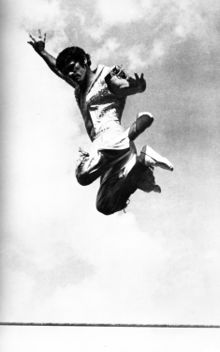Difference between revisions of "Main Page"
From Circopedia
| Line 15: | Line 15: | ||
==In The Spotlight== | ==In The Spotlight== | ||
[[File:Gene_Mendez_jumping.jpeg|right|220px]] | [[File:Gene_Mendez_jumping.jpeg|right|220px]] | ||
| − | === | + | ===PHILIP ASTLEY=== |
| − | + | Philip Astley (1742-1814) is considered the creator of the modern circus. He was born January 8, 1742 in Newcastle-under-Lyme, in the West Midlands, England, the son of Edward Astley, a veneer-cutter and cabinet-maker. Edward had a short-fuse and a passion for horses, traits he passed on to his son. At age 17, Philip left home after one of many disputes with his father and enrolled in the 15th Light Dragoons, a cavalry regiment newly formed by Colonel Granville Elliott. | |
| + | From The Military To Show Business[edit] | ||
| − | + | Six feet tall and endowed with a stentorian voice, Philip Astley was a giant for his time and didn't easily blend into crowds, even when in uniform. A gifted equestrian, he was put in charge of breaking new horses for his regiment. He was also noticed by the celebrated riding and fencing master, Domenico Angelo, who took him under his tutelage and taught him a new method aimed at improving the use of the cavalry broadsword in battle—an expertise Astley would later display in his shows. | |
| − | + | In 1761, Astley and his regiment embarked for the Continent to fight alongside King Frederick II of Prussia in the Seven Years' War (1756-63), known as the French and Indian War in America. Corporal Astley fought gallantly: he captured an enemy standard in battle; rescued the Duke of Brunswick, who had fallen behind enemy lines; and returned to England with the rank of Sergeant Major. He obtained his discharge on June 21, 1766 at Derby, and Elliott, now General, presented him with a white charger named Gibraltar. Astley married around this time. In 1769, his wife (of whom little is known) presented him with a son, John Philip Conway Astley (1767-1821).... ([[Philip Astley|more...]]) | |
==New Biographies== | ==New Biographies== | ||
Revision as of 03:59, 29 November 2016
|
In The Spotlight
PHILIP ASTLEY
Philip Astley (1742-1814) is considered the creator of the modern circus. He was born January 8, 1742 in Newcastle-under-Lyme, in the West Midlands, England, the son of Edward Astley, a veneer-cutter and cabinet-maker. Edward had a short-fuse and a passion for horses, traits he passed on to his son. At age 17, Philip left home after one of many disputes with his father and enrolled in the 15th Light Dragoons, a cavalry regiment newly formed by Colonel Granville Elliott. From The Military To Show Business[edit]
Six feet tall and endowed with a stentorian voice, Philip Astley was a giant for his time and didn't easily blend into crowds, even when in uniform. A gifted equestrian, he was put in charge of breaking new horses for his regiment. He was also noticed by the celebrated riding and fencing master, Domenico Angelo, who took him under his tutelage and taught him a new method aimed at improving the use of the cavalry broadsword in battle—an expertise Astley would later display in his shows.
In 1761, Astley and his regiment embarked for the Continent to fight alongside King Frederick II of Prussia in the Seven Years' War (1756-63), known as the French and Indian War in America. Corporal Astley fought gallantly: he captured an enemy standard in battle; rescued the Duke of Brunswick, who had fallen behind enemy lines; and returned to England with the rank of Sergeant Major. He obtained his discharge on June 21, 1766 at Derby, and Elliott, now General, presented him with a white charger named Gibraltar. Astley married around this time. In 1769, his wife (of whom little is known) presented him with a son, John Philip Conway Astley (1767-1821).... (more...)
New Biographies
- Gene Mendez, High Wire Artist
- Franz Czeisler (Tihany), Magician, Circus Owner
- Circuses Fernando and Medrano, History
- Kannan Bombayo, Rope Dancer
- Réjean St. Jules, Juggler
New Videos
- Budapest's Fővárosi Nagycirkusz, History (2009)
- Darya Zayats, Aerial Straps (2016)
- Charlie Cairoli & Co., Clowns (1979)
- Arlette Gruss, Leopard Act (1969)
- Valery Serebriakov, Clown (1976)
Featured Oral Histories
- Jean Richard and Jean-Pierre Richard at the Cirque jean Richard - Christian Boner Interview (1979)
- Jérôme Medrano about Buster Keaton at the Cirque Medrano (1947)
- Moira Orfei, Circus Owner - Davide Maggio Interview (2012)
- Oleg Popov, clown - Russian Television Feature (2014)
- Albert Fratellini, clown - French Television Interview (1957)
A Message from the Editor
CIRCOPEDIA is a constantly evolving and expanding encyclopedia of the international circus. New videos, biographies, essays, and documents are added to the site on a weekly—and sometimes daily—basis. So keep visiting us: even if today you don't find what you're looking for, it may well be here tomorrow! And if you are a serious circus scholar and spot a factual or historical inaccuracy, do not hesitate to contact us: we will definitely consider your remarks and suggestions.
- Dominique Jando
- Editor/Curator
